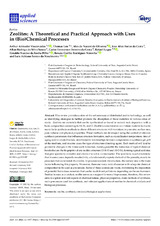Mostrar el registro sencillo del ítem
Zeolites: A Theoretical and Practical Approach with Uses in (Bio)Chemical Processes
| dc.contributor.author | Abinader Vasconcelos, Arthur | |
| dc.contributor.author | Len, Thomas | |
| dc.contributor.author | de Nazaré de Oliveira, Alex | |
| dc.contributor.author | Farias da Costa, Ana Alice | |
| dc.contributor.author | da Silva Souza, Allan Rodrigo | |
| dc.contributor.author | Ferreira da Costa, Carlos Emmerson | |
| dc.contributor.author | Luque, Rafael | |
| dc.contributor.author | da Rocha Filho, Geraldo Narciso | |
| dc.contributor.author | Rodrigues Noronha, Renata Coelho | |
| dc.contributor.author | Santos do Nascimento, Luís Adriano | |
| dc.date.accessioned | 2023-02-02T08:35:45Z | |
| dc.date.available | 2023-02-02T08:35:45Z | |
| dc.date.issued | 2023 | |
| dc.identifier.uri | http://hdl.handle.net/10396/24606 | |
| dc.description.abstract | This review provides a state-of-the-art summary of distributed zeolite technology, as well as identifying strategies to further promote the absorption of these materials in various areas of study. Zeolites are materials that can be synthesized or found in natural rock deposits a with a basic composition consisting in Al, Si, and O. Zeolite’s consideration as a future material is due to many facile synthesis methods to obtain different structures with variations in pore size, surface area, pore volume and physical properties. These methods are developed using the control of relevant synthesis parameters that influences structure formation, such as crystallization temperature, time of aging and/or crystallization, stoichiometric relationships between components of synthesis gel, pH of the medium, and in some cases the type of structure-directing agent. Each method will lead to geometric changes in the framework formation, making possible the formation of typical chemical bonds that are the fingerprint of any zeolitic structure (O-Si-O and Al-O-Si), forming typical acid sites that give specificity in zeolite and allows it to act as a nanoreactor. The specificity is a characteristic that in some cases depends on selectivity, a fundamental property derived of the porosity, mostly in processes that occur inside the zeolite. In processes outside the structure, the surface area is the main factor influencing this property. Moreover, there are many natural sources with adequate chemical composition to be used as precursors. Some of these sources are waste, minimizing the deposition of potential hazardous materials that can be recalcitrant pollutants depending on the environment. Besides its uses as a catalyst, zeolite serves as a support for many bioprocesses; therefore, this review aims to explain relevant aspects in chemical nature, physical properties, main methods of synthesis, main precursors used for synthesis, and relevant applications of zeolites in chemical catalysis and biological processes. | es_ES |
| dc.format.mimetype | application/pdf | es_ES |
| dc.language.iso | eng | es_ES |
| dc.publisher | MDPI | es_ES |
| dc.rights | https://creativecommons.org/licenses/by-nc-nd/4.0/ | es_ES |
| dc.source | Applied Science, 13(3), 1897 (2023) | es_ES |
| dc.subject | Zeolite | es_ES |
| dc.subject | Synthesis | es_ES |
| dc.subject | Catalysis | es_ES |
| dc.subject | Biological applications | es_ES |
| dc.title | Zeolites: A Theoretical and Practical Approach with Uses in (Bio)Chemical Processes | es_ES |
| dc.type | info:eu-repo/semantics/article | es_ES |
| dc.relation.publisherversion | https://doi.org/10.3390/app13031897 | es_ES |
| dc.rights.accessRights | info:eu-repo/semantics/openAccess | es_ES |

